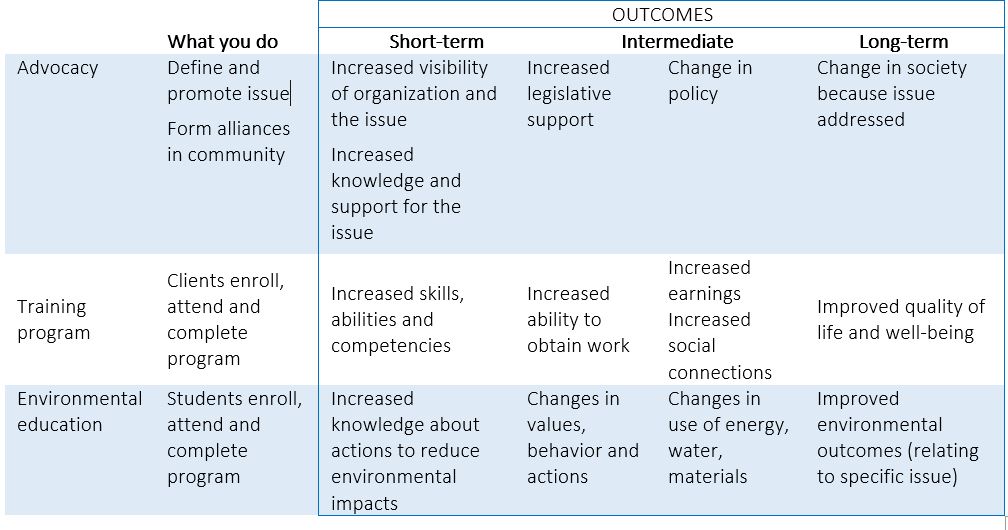 By planning your intended change, you’re breaking down the big, awesome visionary change that is very challenging to measure, into more immediate and visible steps. In this way, impact measurement is more possible and useful. It’s also about breaking out what you can influence and then making the link between that and the bolder, systems-level change that you seek. Mapping out your intended change can really help you focus on what you should and could influence. It can also demonstrate your value and engage others in your mission.
By planning your intended change, you’re breaking down the big, awesome visionary change that is very challenging to measure, into more immediate and visible steps. In this way, impact measurement is more possible and useful. It’s also about breaking out what you can influence and then making the link between that and the bolder, systems-level change that you seek. Mapping out your intended change can really help you focus on what you should and could influence. It can also demonstrate your value and engage others in your mission.
This blog explores how to plan your intended change, one of the five Common Foundations to Impact Measurement. This is the first of a five part blog series that exmines the core elements of impact measurement advanced by Carleton's Centre for Community Innovation's Common Approach initiative. The topic this week is: Planning your Intended Change.
Good planning draws on research, experience and intuition. It also makes use of planning tools. A Theory of Change (and related mapping tools such as a Logic Model and Impact Map) helps people make connections between a desired change and the work on the ground to get there. It acts like a guidepost where you can look for early signs that change is happening. It also helps you interpret what you see and is useful in surfacing assumptions that you are making.
At a very basic level, an outcome is a description of what changes as a result of doing something. This is often described in terms of short-term, intermediate and long-term change. Your initiative has more control over short-term outcomes. Intermediate and long-term outcomes also result from other factors within the system that you seek to change.
Here are 3 really simplified examples:

This exercise becomes more useful if you not only describe what you would like to see and are doing, but how you see it happening and the assumptions that go along with that. This is the key difference between a Theory of Change and Logic Models/ Impact Maps. Great resources for planning your intended change include: University of Wisconsin Extension (Logic Models); Betterevaluation.org (Describe the Theory of Change); Social Impact Navigator (The Logic Model and Its Components); Innovation Network (Logic Model Workbook)
Here are a few tips for planning your intended change:
- Do not articulate specific indicators and targets when you describe an outcome. It is important to start by having a picture of what you would like to see more broadly. Outcomes provide a clear vision of a desired change and help you to make the connections between what you do and that vision.
- In articulating an outcome try to include the common parts of a sentence: the subject of the verb and the object. Outcomes are written as change statements (e.g. increase, decrease, or stay the same). Use an ‘active’ verb.
- You may need to actively integrate outcomes that a (funding) partner has articulated into your own logic model or theory of change. If this is the case, consider the partner’s framework as one of the stakeholders that informs your theory of change.
- If you are presented with an impact map / logic model template, do not get caught up in trying to figure out what goes into specific boxes. Collapse and make your own boxes if you need to.
- Keep in mind that outcomes are beyond the immediate control of your program (project or initiative) but can be influenced by a program.
- Planning should include all important elements and relationships (even if they aren’t in your control) and should be informed by different perspectives and voices.
Demonstrating Value has a number of tools, resources and archived blogs that can help you think through and articulate intended change. Here are a few:
Impact Mapping Worksheet. This resource includes a number of different approaches to planning intended change such as developing a logic model, theory of change and outcome mapping. Outcome mapping differs a little the other two in that it:
Integrates your connection and collaboration with other actors to create systems change.
Describes outcomes in terms of what you “expect to see,” “like to see” and would “love to see”.
Identifies the specific changes to behavior, actions and relationships that would suggest that change is happening.
Sustainable Livelihoods is a holistic framework that relates overall poverty reduction to how individuals build on their strengths.
Community Capitals Framework is similar framework as Sustainable Livelihoods but at a community level.
When it comes to planning the intended change of your program, initiative or social enterprise, proceed with what appeals and makes sense to you and the area you work in. Remember that what you create is only a model of the real world, and as you get a clearer picture of the outcomes and how your work relates to them, use that information to create a better model. If your initiative/business is emerging, rather than spend much time on developing a detailed plan, I recommend looking to innovative evaluation practices, such as development evaluation, that are well positioned to support nimble decision-making and learning so that you can quickly gain and interpret new evidence. For instance, see Developmental Evaluation at BetterEvaluation.org. If you are working towards colloborative change in a complex societal problem, ‘systems mapping’ and associated tools may be more useful, see FSG (Systems Thinking Toolkit).
